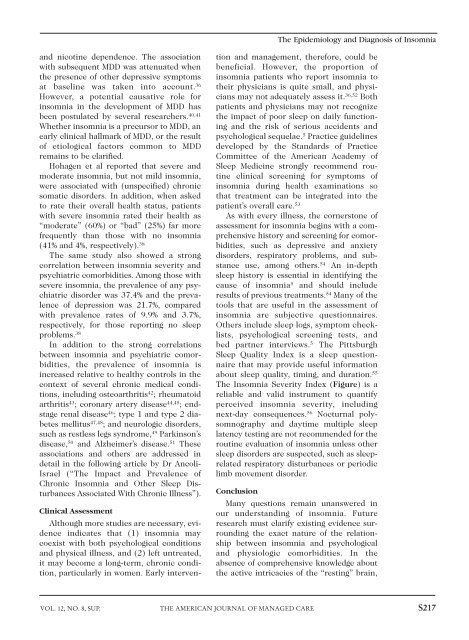SHIFT WORK DISORDER - myCME.com
SHIFT WORK DISORDER - myCME.com
SHIFT WORK DISORDER - myCME.com
- No tags were found...
You also want an ePaper? Increase the reach of your titles
YUMPU automatically turns print PDFs into web optimized ePapers that Google loves.
The Epidemiology and Diagnosis of Insomniaand nicotine dependence. The associationwith subsequent MDD was attenuated whenthe presence of other depressive symptomsat baseline was taken into account. 36However, a potential causative role forinsomnia in the development of MDD hasbeen postulated by several researchers. 40,41Whether insomnia is a precursor to MDD, anearly clinical hallmark of MDD, or the resultof etiological factors <strong>com</strong>mon to MDDremains to be clarified.Hohagen et al reported that severe andmoderate insomnia, but not mild insomnia,were associated with (unspecified) chronicsomatic disorders. In addition, when askedto rate their overall health status, patientswith severe insomnia rated their health as“moderate” (60%) or “bad” (25%) far morefrequently than those with no insomnia(41% and 4%, respectively). 38The same study also showed a strongcorrelation between insomnia severity andpsychiatric <strong>com</strong>orbidities. Among those withsevere insomnia, the prevalence of any psychiatricdisorder was 37.4% and the prevalenceof depression was 21.7%, <strong>com</strong>paredwith prevalence rates of 9.9% and 3.7%,respectively, for those reporting no sleepproblems. 38In addition to the strong correlationsbetween insomnia and psychiatric <strong>com</strong>orbidities,the prevalence of insomnia isincreased relative to healthy controls in thecontext of several chronic medical conditions,including osteoarthritis 42 ; rheumatoidarthritis 43 ; coronary artery disease 44,45 ; endstagerenal disease 46 ; type 1 and type 2 diabetesmellitus 47,48 ; and neurologic disorders,such as restless legs syndrome, 49 Parkinson’sdisease, 50 and Alzheimer’s disease. 51 Theseassociations and others are addressed indetail in the following article by Dr Ancoli-Israel (“The Impact and Prevalence ofChronic Insomnia and Other Sleep DisturbancesAssociated With Chronic Illness”).Clinical AssessmentAlthough more studies are necessary, evidenceindicates that (1) insomnia maycoexist with both psychological conditionsand physical illness, and (2) left untreated,it may be<strong>com</strong>e a long-term, chronic condition,particularly in women. Early interventionand management, therefore, could bebeneficial. However, the proportion ofinsomnia patients who report insomnia totheir physicians is quite small, and physiciansmay not adequately assess it. 36,52 Bothpatients and physicians may not recognizethe impact of poor sleep on daily functioningand the risk of serious accidents andpsychological sequelae. 5 Practice guidelinesdeveloped by the Standards of PracticeCommittee of the American Academy ofSleep Medicine strongly re<strong>com</strong>mend routineclinical screening for symptoms ofinsomnia during health examinations sothat treatment can be integrated into thepatient’s overall care. 53As with every illness, the cornerstone ofassessment for insomnia begins with a <strong>com</strong>prehensivehistory and screening for <strong>com</strong>orbidities,such as depressive and anxietydisorders, respiratory problems, and substanceuse, among others. 54 An in-depthsleep history is essential in identifying thecause of insomnia 5 and should includeresults of previous treatments. 54 Many of thetools that are useful in the assessment ofinsomnia are subjective questionnaires.Others include sleep logs, symptom checklists,psychological screening tests, andbed partner interviews. 5 The PittsburghSleep Quality Index is a sleep questionnairethat may provide useful informationabout sleep quality, timing, and duration. 55The Insomnia Severity Index (Figure) is areliable and valid instrument to quantifyperceived insomnia severity, includingnext-day consequences. 56 Nocturnal polysomnographyand daytime multiple sleeplatency testing are not re<strong>com</strong>mended for theroutine evaluation of insomnia unless othersleep disorders are suspected, such as sleeprelatedrespiratory disturbances or periodiclimb movement disorder.ConclusionMany questions remain unanswered inour understanding of insomnia. Futureresearch must clarify existing evidence surroundingthe exact nature of the relationshipbetween insomnia and psychologicaland physiologic <strong>com</strong>orbidities. In theabsence of <strong>com</strong>prehensive knowledge aboutthe active intricacies of the “resting” brain,VOL. 12, NO. 8, SUP. THE AMERICAN JOURNAL OF MANAGED CARE S217
















